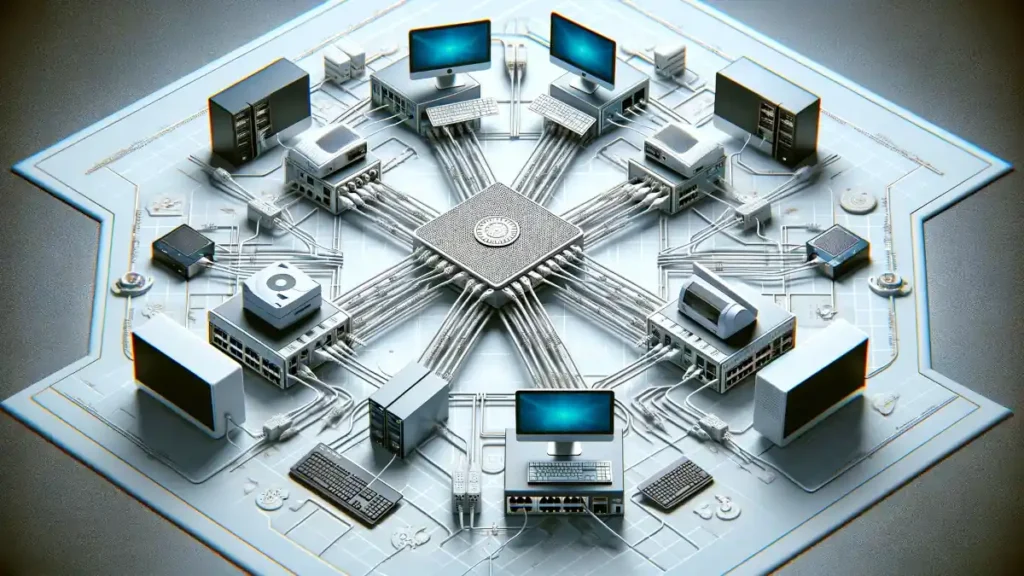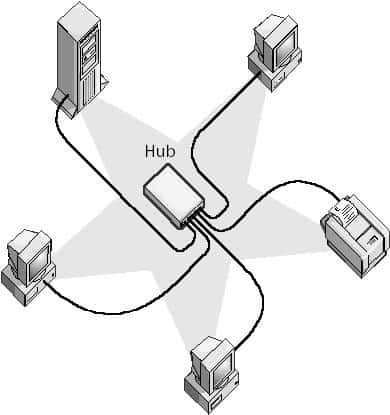Star Topology remains a cornerstone in the design of modern networks. Revered for its robustness and scalability, it forms the basis of many contemporary networking infrastructures. This article aims to provide a deep dive into the concept of Star Topology. From its foundational principles to its evolution and practical applications, we will explore the facets that make Star Topology a preferred choice in network design.
Table of Contents:
- What is Star Topology?
- Historical Context
- How Data Travels in a Physical Star
- Understanding the Difference between Physical and Logical Topology
- Physical Star Disadvantages
- Extended Star
- Star Topology in Modern Networks
- References

1. What is Star Topology?
Star Topology is a network configuration where each node (computer, printer, etc.) is independently connected to a central network hub or switch. This setup forms a star-like pattern, with the central hub acting as a conduit for data transmission. The distinct feature of Star Topology is its centralized nature, which simplifies network management and enhances performance.
When a computer or other networking component transmits a signal to the network, the signal travels to the hub, which forwards the signal simultaneously to all other components connected to the hub.
Star topology is used to:
- Connect computers in a workgroup or departmental local area network (LAN) using a hub.
- Connect workgroup or departmental hubs using a master hub or switch. This is a special star topology called either cascading hubs or star-wired topology.
Star topology is the most popular way to connect computers in a workgroup or departmental LAN, but it is slightly more expensive than using bus topology. One advantage of star topology is that the failure of a single computer or cable doesn’t bring down the entire LAN. This topology also centralizes networking equipment, which can reduce costs in the long run by making network management much easier.

2. Historical Context
The inception of Star Topology can be traced back to the late 1980s and early 1990s, a period marked by significant technological advancements in networking. Initially, network designs like the bus topology dominated, but they had limitations in scalability and reliability. The advent of Star Topology addressed these issues, offering a more stable and scalable network framework. Its rise to prominence was fueled by the decreasing costs of cabling and the increasing demand for efficient network infrastructures.
The evolution of network topologies is a fascinating journey through the history of computing and networking. While Star Topology stands out for its widespread adoption, it is part of a broader landscape of network designs, each with its unique characteristics and historical significance.
- Bus Topology (Late 1970s): One of the earliest network topologies, the bus topology, features a single central cable (the bus) to which all network devices are connected. Data sent from a device travels along the bus until it reaches its destination. This simplicity made it popular in the early days of networking but limited scalability and collision issues eventually led to its decline.
- Ring Topology (1980s): Characterized by a closed-loop configuration where each device is connected to two others, forming a ring-like structure. In a ring topology, data travels in one direction, passing through each device until it reaches its destination. It was popularized by IBM’s Token Ring technology in the 1980s.
- Mesh Topology (Late 1980s): This topology emerged as networks grew more complex. In a full mesh topology, each device is connected to every other device in the network, creating a web-like structure. This ensures high redundancy and reliability, as there are multiple paths for data transmission, but it can be expensive and complex to implement.
- Tree Topology (1990s): Combining elements of star and bus topologies, tree topology features a series of star-configured networks connected to a linear bus backbone. This hierarchical structure is ideal for large-scale networks, offering good scalability and ease of management.
- Hybrid Topology (1990s and Beyond): As networks evolved, the need for more flexible and scalable designs led to the development of hybrid topologies, which combine two or more different types of topologies. This approach allows for optimization based on specific network requirements and has become increasingly common in complex network environments.
Star Topology’s inception and rise to prominence in the late 1980s and early 1990s must be viewed within this broader historical context. Its development was a response to the limitations of earlier topologies and a reflection of the growing complexity and demands of network environments. This timeline of network topologies underscores the dynamic nature of network design, constantly evolving to meet the changing needs of technology and business.
3. How Data Travels in a Physical Star
In a physical Star Topology, data transmission begins at an endpoint device and travels through a single cable to the central hub or switch. The nature of this transmission varies based on the central device. For example, in a hub-based network, data is broadcasted to all connected nodes, whereas, in a switch-based network, data is intelligently directed to the intended recipient, enhancing efficiency and security.
4. Understanding the Difference between Physical and Logical Topology
Physical topology refers to the actual physical layout of the devices on the network, such as the cabling and connections. In contrast, logical topology describes the path that the data takes within the network infrastructure. In a Star Topology, while the physical layout is star-shaped, the logical topology can vary depending on the central networking device used.
For example, with a hub, the logical topology resembles a bus, as data is broadcast to all nodes. With a switch, the logical topology is more direct, as data is sent only to the intended recipient.
5. Physical Star Disadvantages
Despite its advantages, the physical Star Topology has some drawbacks. The most notable is the single point of failure: the central hub or switch. If this device fails, the entire network can be incapacitated. This vulnerability necessitates having backup systems or redundant devices to ensure network reliability. Additionally, the initial argument against Star Topology was the increased cabling requirement compared to a bus network, which could elevate installation costs. However, this concern has diminished over time with the reduction in cabling costs and the significant advantages offered by Star Topology.
6. Extended Star
The Extended Star Topology, or hierarchical star, is a variation of the basic star configuration and is commonly used in larger networks. In this topology, instead of directly connecting all nodes to a single central hub, secondary hubs or switches are connected to the primary central device. These secondary devices, in turn, have nodes connected to them. This arrangement allows for scalability, enabling the connection of a large number of devices while maintaining the central management benefits of a star network.
7. Star Topology in Modern Networks
Today, Star Topology remains prevalent in network design due to its inherent advantages in performance, reliability, and ease of troubleshooting. Its adaptability to incorporate advanced technologies like fiber optics and wireless connections further cements its relevance in modern network architectures. The topology’s ability to integrate with various networking devices and protocols makes it a versatile choice for diverse networking requirements.
8. References
- Tomsho, G. (2015). Guide to Networking Essentials, 7th Edition.
- Panek, C. (2020). Networking Fundamentals.
- What is the Star Bus topology?, Network Encyclopedia